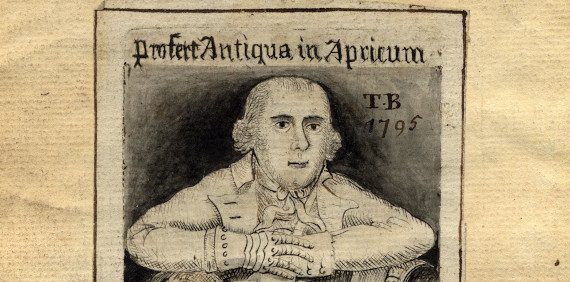- About
- Visiting
- What’s On
- Venue hire
- Catalogues
- Collections
- 101 Treasures of Chetham’s
- Digital Resources
- The Flowers of Histories
- A Book of Hours from France
- The Manchester Scrapbook
- Thomas Barritt of Manchester
- Art Treasures Examiner of 1857
- Manchester Association for Constitutional Order
- The North Western Museum of Science and Industry: Some Reminiscences by Richard Hills
- Criminal Manchester
- The Cup of Destiny
- Athenaeum Souvenir
- Middle English Manuscripts
- Manchester and Liverpool of Today
- Hollingworth’s Mancuniensis
- Memoir of Cecil Wray
- William Seward’s Diary
- The Anti-Monopolist
- Fishwick’s History of Rochdale
- Knyvett’s Defence of this Realm
- Tractatus de Nigromantia
- Axon Ballads
- Printed Books & Ephemera
- Archives & Manuscripts
- Prints and Photographs
- Blog
- Support us
Thomas Barritt of Manchester
Saddlemaker, Antiquarian, Artist, Mancunian

‘He brings ancient things to light’ – Barritt in his own bookplate
In a new departure for the Library into the world of video, we’re delighted to work in partnership with Manchester, Metropolitan University to co-curate an in-depth study of Thomas Barritt with Visiting Curator Dr Peter N. Lindfield FSA from the Department of History and Centre for Gothic Studies.
Thomas Barritt (1743–1820) was, by all accounts, a prolific antiquary working out of his base on Hanging Ditch, close to the site of Chetham’s Library. Today, Chetham’s holds the majority of Thomas Barritt’s archive and manuscripts; this is rather fitting given how he appears to have made use of the Library’s collection for his personal researches. Working as a saddler, Barritt found plenty of time to engage in antiquarian pursuits. His study of the past was not restricted to local, domestic artefacts, such as medieval and Roman fragments dug up in fields, but it extended to exploring the built heritage of Manchester, Lancashire, and further afield, as well as family histories, and also heraldry. You can see a number of images by Barritt on our Manchester Scrapbook page.
The five following videos prepared by Dr Lindfield explore the breadth, depth, and wealth of Barritt’s antiquarian and topographical interests; they bring to life this remarkable Georgian Mancunian, and also the history of Lancashire. They are based heavily upon Barritt’s materials in Chetham’s, and also his recent studies of Barritt’s interest in heraldry and antiquarianism.
1 : Introduction
With an apparent humble origin, Barritt developed an early interest in antiquities, family history, topography, and heraldry. This video introduces and explores Barritt’s life and history.
2 : Topographical Antiquary
Antiquaries were often interested in exploring the remains of historic architecture and the families and narratives surrounding them. This video, and the interactive map below tracing his surveying of such buildings, examines his interest in Lancashire’s built heritage—and beyond.
Follow Barritt’s activity in Lancashire and beyond!
3 : Collecting and Reproduction
Thomas Barritt, like any good Georgian antiquary, collected material representing his interest in the past. This video examines some of his most interesting acquisitions, and it also demonstrates how he copied historic manuscripts to include them in his personal library. There is an interesting fine line between copying and forgery, and this video also demonstrates his accomplished artist skill, particularly in calligraphy and illumination.
4 : Heraldry
One of the most cultivated skills an antiquary could possess in Georgian England was the ability to read, decipher, and understand heraldry—or, coats of arms. Barritt’s interest in heraldry developed as a teenager, and this video explores his understanding and interest in this visual language signifying rank and station.
5 : Antiquarian Imagination and Conclusion
Barritt’s interest in heraldry and antiquarian pursuits generally was not limited to copying and interpretation. He actively created new antiquarian material, or material based upon antiquarian knowledge; this video explores the wealth of his artistic visualisations, including his Heraldic Poem, and how such productions were based upon a lifetime of antiquarian research.
Published Research
Peter N. Lindfield, ‘Lancashire’s Armoury: Thomas Barritt, Saddler-Antiquary’, in F. Robertson and P.N. Lindfield (eds), The Display of Heraldry: The Heraldic Imagination in Arts and Culture (The Heraldry Society: 2019), pp. 156–75, accessible here.
Peter N. Lindfield, “‘Heraldic Antiquarianism: The Early Work of Thomas Barritt of Manchester”, Bodleian Library Record Vol. 27.2 (2014), pp. 178–202, accessible here.

